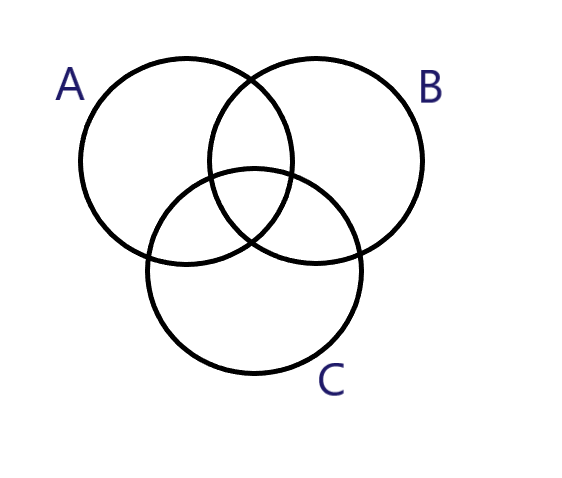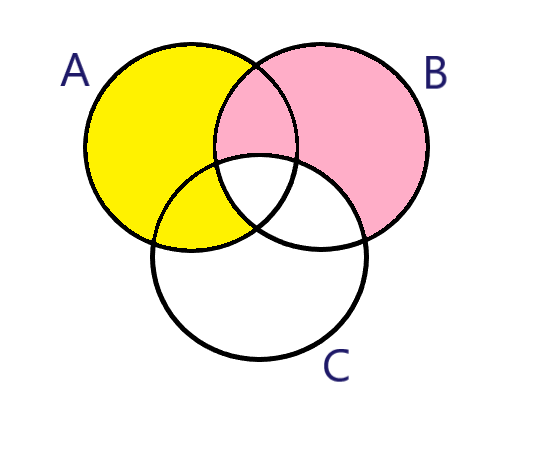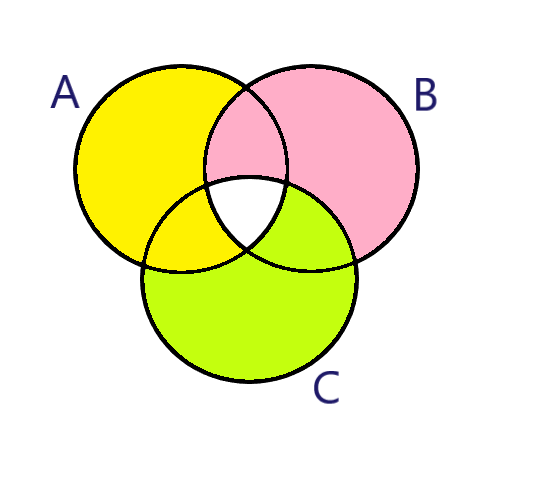
Let $U$ be the universal set and $A \cup B \cup C = U$. Then $\left\{ {\left( {A - B} \right) \cup \left( {B - C} \right) \cup \left( {C - A} \right)} \right\}'$ is equal to
A.$A \cup B \cup C$
B.$A \cup \left( {B \cap C} \right)$
C.$A \cap B \cap C$
D.$A \cap \left( {B \cup C} \right)$
Answer
440.1k+ views
Hint: In order to find the value of $\left\{ {\left( {A - B} \right) \cup \left( {B - C} \right) \cup \left( {C - A} \right)} \right\}'$, initiate with the drawing the Venn diagram of sets separately like for $\left( {A - B} \right)$, $\left( {B - C} \right)$ and $\left( {C - A} \right)$, find their union and then complement them. Complement will represent the part which is not covered by the unions. And, we will get the required results.
Complete answer:
We are given with three sets: A, B and C. And, some set equations are given, so we will use Venn diagrams to solve for $\left\{ {\left( {A - B} \right) \cup \left( {B - C} \right) \cup \left( {C - A} \right)} \right\}'$.
So, basically, we are given with $A \cup B \cup C = U$. Means all the elements of the sets combine to form the Universal set, which in diagram is represented as:

Now, we would start with finding the values separately in $\left\{ {\left( {A - B} \right) \cup \left( {B - C} \right) \cup \left( {C - A} \right)} \right\}'$,.
Starting with $\left( {A - B} \right)$. Basically, $\left( {A - B} \right)$ it depicts the region which has all A elements except the portion which has B elements, represented as:

The Yellow portion shows $\left( {A - B} \right)$.
Now, for $\left( {B - C} \right)$, the Area’s which covers all elements of B but not C.
The pink color represents that:

And, it gives $\left( {A - B} \right) \cup \left( {B - C} \right)$.
Now, for $\left( {C - A} \right)$.
The Area which has all elements of C but not the elements of A. Represented as green color:

And, now it gives \[\left\{ {\left( {A - B} \right) \cup \left( {B - C} \right) \cup \left( {C - A} \right)} \right\}\].
But we need the complement of the value. Complement means the portion which are in Universal set but not in \[\left\{ {\left( {A - B} \right) \cup \left( {B - C} \right) \cup \left( {C - A} \right)} \right\}\].
So, the portion becomes:
\[\left\{ {\left( {A - B} \right) \cup \left( {B - C} \right) \cup \left( {C - A} \right)} \right\}' = U - \left\{ {\left( {A - B} \right) \cup \left( {B - C} \right) \cup \left( {C - A} \right)} \right\}\]
And, in the above diagram it is the white portion in the middle, which shows that. And, the portion is \[A \cap B \cap C\], the intersection of the three sets.
Therefore, $\left\{ {\left( {A - B} \right) \cup \left( {B - C} \right) \cup \left( {C - A} \right)} \right\}'$ is equal to \[A \cap B \cap C\].
Therefore, option (C) is the correct answer.
Note:
-Universal sets are always represented by capital U. And, complement is represented with a single quote, for example: A’ is the complement of A.
-Venn Diagram is the best method to find the intersection and union of sets. So, it is always preferred to use Venn diagrams.
Complete answer:
We are given with three sets: A, B and C. And, some set equations are given, so we will use Venn diagrams to solve for $\left\{ {\left( {A - B} \right) \cup \left( {B - C} \right) \cup \left( {C - A} \right)} \right\}'$.
So, basically, we are given with $A \cup B \cup C = U$. Means all the elements of the sets combine to form the Universal set, which in diagram is represented as:

Now, we would start with finding the values separately in $\left\{ {\left( {A - B} \right) \cup \left( {B - C} \right) \cup \left( {C - A} \right)} \right\}'$,.
Starting with $\left( {A - B} \right)$. Basically, $\left( {A - B} \right)$ it depicts the region which has all A elements except the portion which has B elements, represented as:

The Yellow portion shows $\left( {A - B} \right)$.
Now, for $\left( {B - C} \right)$, the Area’s which covers all elements of B but not C.
The pink color represents that:

And, it gives $\left( {A - B} \right) \cup \left( {B - C} \right)$.
Now, for $\left( {C - A} \right)$.
The Area which has all elements of C but not the elements of A. Represented as green color:

And, now it gives \[\left\{ {\left( {A - B} \right) \cup \left( {B - C} \right) \cup \left( {C - A} \right)} \right\}\].
But we need the complement of the value. Complement means the portion which are in Universal set but not in \[\left\{ {\left( {A - B} \right) \cup \left( {B - C} \right) \cup \left( {C - A} \right)} \right\}\].
So, the portion becomes:
\[\left\{ {\left( {A - B} \right) \cup \left( {B - C} \right) \cup \left( {C - A} \right)} \right\}' = U - \left\{ {\left( {A - B} \right) \cup \left( {B - C} \right) \cup \left( {C - A} \right)} \right\}\]
And, in the above diagram it is the white portion in the middle, which shows that. And, the portion is \[A \cap B \cap C\], the intersection of the three sets.
Therefore, $\left\{ {\left( {A - B} \right) \cup \left( {B - C} \right) \cup \left( {C - A} \right)} \right\}'$ is equal to \[A \cap B \cap C\].
Therefore, option (C) is the correct answer.
Note:
-Universal sets are always represented by capital U. And, complement is represented with a single quote, for example: A’ is the complement of A.
-Venn Diagram is the best method to find the intersection and union of sets. So, it is always preferred to use Venn diagrams.
Recently Updated Pages
Master Class 12 Biology: Engaging Questions & Answers for Success

Master Class 12 Physics: Engaging Questions & Answers for Success

Master Class 12 Economics: Engaging Questions & Answers for Success

Master Class 12 Maths: Engaging Questions & Answers for Success

Master Class 11 Economics: Engaging Questions & Answers for Success

Master Class 11 Accountancy: Engaging Questions & Answers for Success

Trending doubts
Which are the Top 10 Largest Countries of the World?

Differentiate between homogeneous and heterogeneous class 12 chemistry CBSE

Why is the cell called the structural and functional class 12 biology CBSE

a Tabulate the differences in the characteristics of class 12 chemistry CBSE

Who discovered the cell and how class 12 biology CBSE

Draw a labelled sketch of the human eye class 12 physics CBSE




